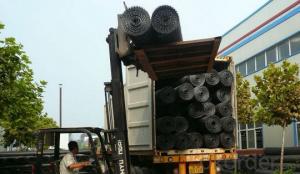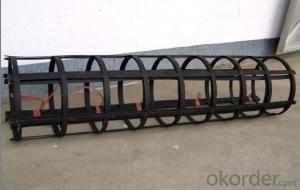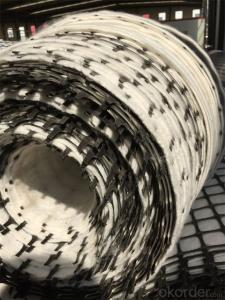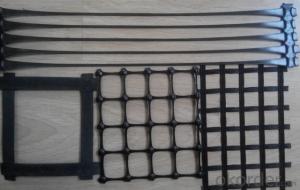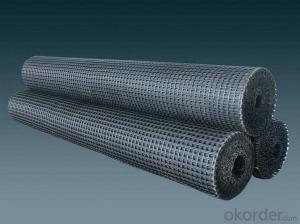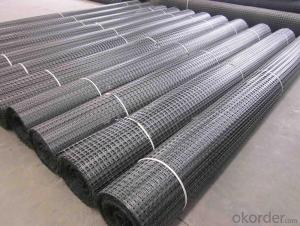Interlock Fiberglass Geogrids with CE Certificates - Factory Supply
- Loading Port:
- Qingdao
- Payment Terms:
- TT OR LC
- Min Order Qty:
- 5000 m²
- Supply Capability:
- 2000000 m²/month
OKorder Service Pledge
OKorder Financial Service
You Might Also Like
Specifications of Geogrid:
Glassfiber Geogrid(Fiberglass geogrid)
1)fiberglass geogrids
2)Materials:fiberglass
3) Tensile strength:MD/CD:30 ~ 150kn/m
Applications of Geogrid:
Make reinforce treatment for various kinds of soft soil foundation to evenly distribute load stress and reduce uneven settlement, not easy to generate static electricity, and flammability property good in the coal mine. It is easy to wash coal.
Used in highway, railway, port, airport and municipal project. Support in the recovery working face of coal mine and roadway in the coal mine.
Index Properties | Test Method | Unit | GG1515 | GG2020 | GG3030 | GG4040 |
MD TD | MD TD | MD TD | MD TD | |||
Polymer | -- | -- | PP | PP | PP | PP |
Minimum Carbon Black | ASTM D 4218 | % | 2 | 2 | 2 | 2 |
Tensile Strength@ 2% Strain | ASTM D 6637 | Kn/m | 5 5 | 7 7 | 10.5 10.5 | 14 14 |
Tensile Strength@ 5% Strain | ASTM D 6637 | Kn/m | 7 7 | 14 14 | 21 21 | 28 28 |
Ultimate Tensile Strength | ASTM D 6637 | Kn/m | 15 15 | 20 20 | 30 30 | 40 40 |
Strain @ Ultimate Strength | ASTM D 6637 | % | 13 10 | 13 10 | 13 10 | 13 10 |
Structural Integrity | ||||||
Junction Efficiency | GRI GG2 | % | 93 | 93 | 93 | 93 |
Flexural Rigidity | ASTM D 1388 | Mg-cm | 700000 | 1000000 | 3500000 | 10000000 |
Aperture Stability | COE Method | mm-N/deg | 646 | 707 | 1432 | 2104 |
Dimensions | ||||||
Roll Width | -- | M | 3.95 | 3.95 | 3.95 | 3.95 |
Roll Length | -- | M | 50 | 50 | 50 | 50 |
Roll Weight | -- | Kg | 39 | 50 | 72 | 105 |
MD denotes Machine direction. TD denotes transverse direction. | ||||||
Property of Geogrid:
1.) Improve roadbed bearing capacity,enlarge road lifetime.
2.) Prevent road collapse and crack
3.) Prevent soil and water loss in slope
4.) Could replace steel-plastic geogrid in coal mine.
FAQ:
1. How to order your geogrid ?
a). Tensile strength in warp & weft direction
b). Grid size
c). Width and length
d). Quantity
2. Payment term .
a) TT
b) LC AT SIGHT
c) cash
d) 30% contact value as deposit ,the blance 70% be paid after received the copy of bl .
3. Delivery time
a) 19-25 days after received your depsit .
4. What is MQQ ?
a) 2500 m2 as MQQ , we can also produce sample for you .
Geogrid Show:




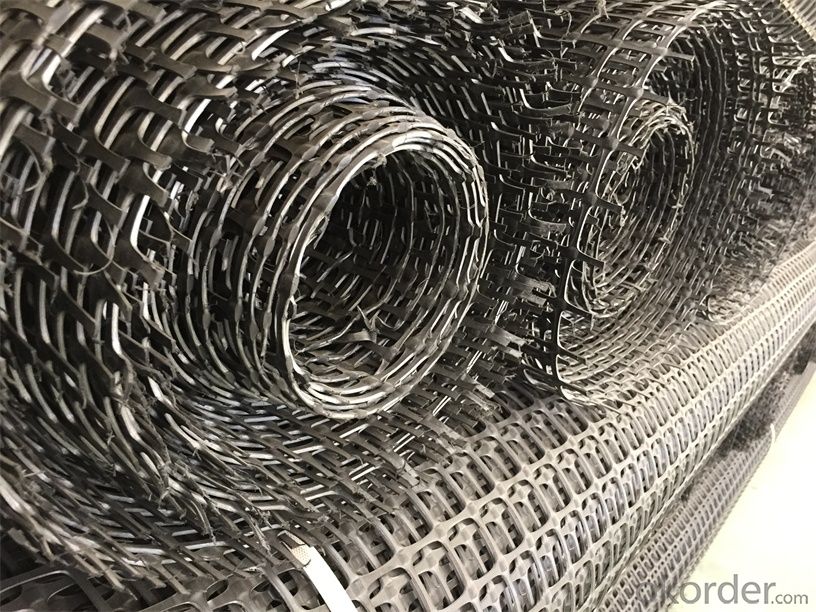
- Q: What is the effect of moisture on geogrid performance?
- Moisture can have both positive and negative effects on geogrid performance. On one hand, moisture can enhance the interlock between the geogrid and the surrounding soil, improving its overall stability and load-bearing capacity. This is particularly beneficial in clayey or cohesive soils where moisture helps to increase the soil's strength and reduce its potential for settlement. On the other hand, excessive moisture can lead to the loss of geogrid strength due to hydrolysis or chemical degradation, especially in certain polymer-based geogrids. Additionally, waterlogged conditions can increase the likelihood of soil erosion, reducing the effectiveness of the geogrid in retaining soil particles. Therefore, while some moisture is generally beneficial, proper drainage and moisture control are crucial factors to consider for optimal geogrid performance.
- Q: Are geogrids effective in preventing soil erosion on slopes with vegetation?
- Yes, geogrids are effective in preventing soil erosion on slopes with vegetation. Geogrids provide structural support to the soil, preventing it from being washed away by water or blown away by wind. This helps to maintain the stability of the slope and protects the vegetation from being uprooted. Additionally, geogrids help to reinforce the root systems of plants, enhancing their ability to hold the soil in place. Overall, geogrids are a valuable tool in preventing soil erosion on slopes with vegetation.
- Q: What is the typical length of a geogrid roll?
- The typical length of a geogrid roll can vary depending on the manufacturer and application, but it is usually around 50 to 100 meters in length.
- Q: What are the different materials used to manufacture geogrids?
- Geogrids are manufactured using various materials such as polyester, polypropylene, high-density polyethylene (HDPE), and fiberglass. These materials offer different strengths, durability, and chemical resistances, allowing geogrids to be customized for various applications in civil engineering and construction projects.
- Q: Are geogrids effective in reducing soil erosion?
- Yes, geogrids are effective in reducing soil erosion. Geogrids provide stabilization and reinforcement to the soil, preventing it from being washed away by water or wind. They act as a barrier, holding the soil in place and reducing the chances of erosion occurring. Additionally, geogrids improve the overall strength and integrity of the soil, making it more resistant to erosion in the long term.
- Q: Can geogrids be used in soil erosion control for agriculture?
- Yes, geogrids can be used in soil erosion control for agriculture. Geogrids are commonly used to reinforce soil and prevent erosion by stabilizing the soil structure. They can be installed in agricultural fields to enhance the integrity of the soil, reduce surface runoff, and retain moisture, thereby minimizing soil erosion and promoting better crop growth.
- Q: Where are the bi - directional bi directional 40kN geogrid, geogrid price, geo material suppliers
- Welding geogrid two-way plastic geogrid two-way steel plastic geogrid two-way steel plastic composite geogrid welcome to call manager
- Q: Can geogrids be used in reinforced slopes?
- Yes, geogrids can be used in reinforced slopes. Geogrids are commonly used in reinforced slopes to enhance the stability and strength of the soil. They are designed to distribute the load and provide additional reinforcement to the slope, improving its resistance against erosion and slope failures.
- Q: How do geogrids improve the performance of reinforced soil walls?
- Geogrids improve the performance of reinforced soil walls by providing tensile strength and stability to the soil structure. They act as a reinforcement material, distributing the applied loads and preventing soil movement and potential failure. The geogrids interlock with the surrounding soil, increasing its resistance to lateral forces and improving overall stability and durability of the reinforced soil wall.
- Q: What type of geogrid is CATTXDJ?
- 1 Introduction geogrid: Geogrid geogrid is a kind of main geosynthetics, which has unique properties and effects compared with other geosynthetics. Geogrid is often used as reinforcement of reinforced soil structure or composite material. Geogrid is divided into four categories: plastic geogrid, steel plastic geogrid, fiberglass geogrid and polyester warp knitted polyester geogrid. 2 classification of plastic woven through the formation of a square or rectangular polymer mesh material, according to the direction of its manufacturing can be different for different types of uniaxial tension and biaxial tensile two
Send your message to us
Interlock Fiberglass Geogrids with CE Certificates - Factory Supply
- Loading Port:
- Qingdao
- Payment Terms:
- TT OR LC
- Min Order Qty:
- 5000 m²
- Supply Capability:
- 2000000 m²/month
OKorder Service Pledge
OKorder Financial Service
Similar products
Hot products
Hot Searches
Related keywords





